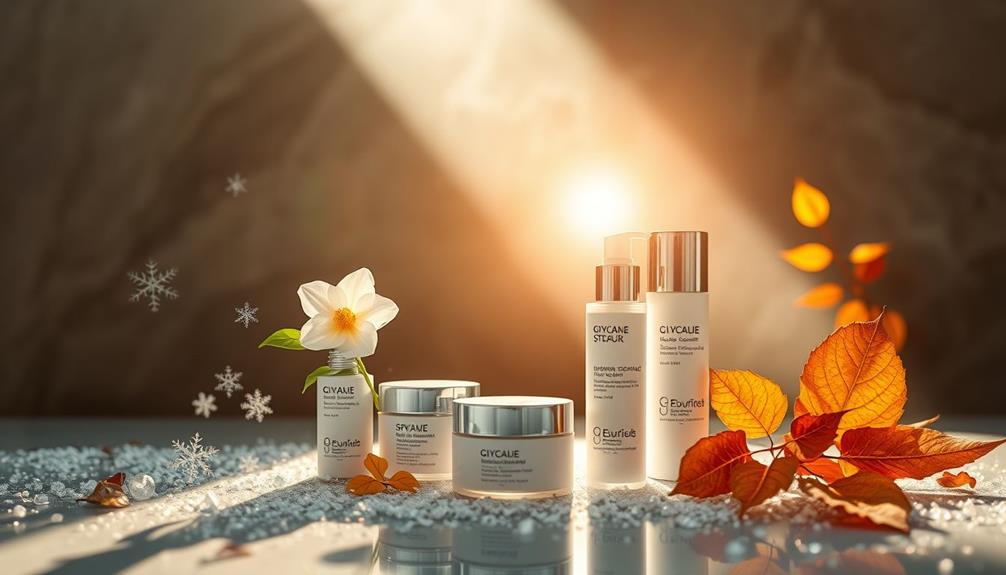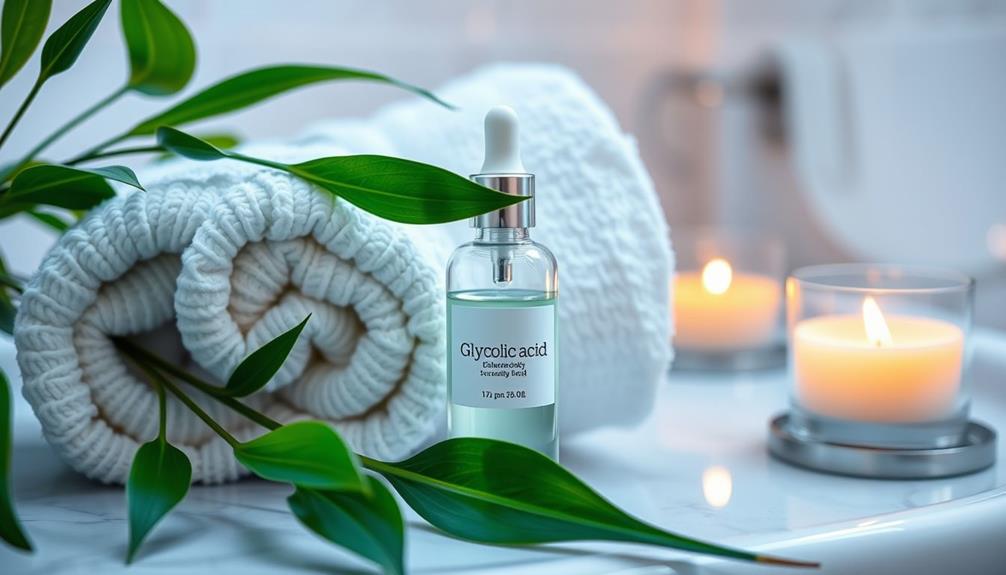Glycolic acid is revolutionizing the skincare industry with its remarkable anti-aging and exfoliating benefits. Thanks to its small molecular structure, it can penetrate deeply into the skin, promoting cell turnover and revealing a fresh complexion. By boosting collagen production, it helps fade dark spots and reduce fine lines, while also keeping acne under control. For optimal results, it is important to start with lower concentrations and combine it with soothing ingredients. Keep an eye out for more information on how Glycolic acid can improve your skincare routine and effectively address your skin concerns.
Key Takeaways
- Glycolic acid accelerates skin cell turnover, leading to a brighter and smoother complexion by effectively shedding dead skin cells.
- Its ability to stimulate collagen production improves skin firmness, reducing fine lines and enhancing overall skin elasticity.
- Glycolic acid serves as an effective acne treatment, clearing clogged pores and minimizing breakouts while inhibiting acne-causing bacteria.
- The humectant properties of glycolic acid attract moisture, maintaining hydration levels and promoting overall skin health.
Understanding Glycolic Acid

Glycolic acid is a powerful alpha hydroxy acid that deeply exfoliates your skin, revealing a brighter and smoother complexion.
Derived from sugar cane, this AHA has a small molecular structure that allows it to penetrate the skin effectively. By promoting skin cell turnover, glycolic acid dissolves the bonds between dead skin cells, enhancing your skin's texture.
Additionally, incorporating essential oils into your routine can further support skin health, as they offer natural alternatives to chemical products and have antimicrobial properties.
When you incorporate glycolic acid into your skincare routine, you'll notice improved hydration as it acts as a humectant, attracting moisture to your skin. This increased moisture not only contributes to a plumper appearance but also aids in reducing the visibility of fine lines and wrinkles.
Regular use of glycolic acid in skincare products can stimulate collagen production, helping to improve skin firmness over time.
With concentrations typically ranging from 5% to 20%, it's vital to select the right product for your skin type to achieve best results.
Mechanism of Action

Understanding how glycolic acid works discloses its effectiveness in exfoliating the skin and promoting a healthier complexion. Its mechanism of action involves dissolving the bonds that hold dead skin cells together on the surface. When you apply glycolic acid, it encourages these cells to shed, revealing fresher skin beneath and improving overall skin texture.
Additionally, incorporating aromatherapy techniques can further enhance your skincare routine by promoting relaxation and reducing stress, which can positively impact skin health.
Thanks to its small molecular structure, glycolic acid penetrates deeply, addressing issues like uneven texture and pigmentation. By accelerating cell turnover, it stimulates collagen production, enhancing skin elasticity and firmness, which contributes to a more youthful appearance.
Additionally, glycolic acid acts as a humectant, attracting and binding moisture to your skin, helping to maintain hydration even while exfoliating. Its antibacterial properties also play a significant role in skincare, inhibiting the growth of acne-causing bacteria.
This makes glycolic acid particularly beneficial for treating various types of acne, especially comedonal acne. By incorporating glycolic acid into your skincare routine, you harness its powerful mechanism of action for clearer, smoother, and more radiant skin.
Benefits for Skin

Experience the transformative benefits of glycolic acid as it revitalizes your skin, offering a brighter, smoother, and more youthful complexion. This powerhouse ingredient, the smallest alpha hydroxy acid (AHA), effectively works as a chemical exfoliant, targeting dead skin cells and enhancing your skin texture.
With regular use, the benefits of glycolic acid include accelerated cell turnover that helps fade dark spots and hyperpigmentation, giving you a more even skin tone. Additionally, incorporating ingredients like rooibos tea can further enhance your skincare routine due to its rich antioxidant properties, promoting overall skin health.
Glycolic acid also stimulates collagen production, which improves skin firmness and elasticity while reducing fine lines and wrinkles over time. Additionally, it's known for its hydrating properties; acting as a humectant, it attracts moisture to your skin, essential for maintaining hydration levels and overall skin health.
If you struggle with breakouts, glycolic acid is an effective acne treatment, clearing clogged pores and minimizing the occurrence of acne. By incorporating glycolic acid into your skincare routine, you'll not only enhance your skin's appearance but also promote long-term health and wellness, making it a must-have for anyone looking to improve their skin.
Application Techniques

To reap the full benefits of glycolic acid, proper application techniques play a crucial role in maximizing its effectiveness while minimizing potential irritation.
It's vital to acknowledge that just as regular screenings, like mammography effectiveness, can help in early detection of issues, proper skincare routines can greatly improve skin health.
Here's how to get the most out of your glycolic acid routine:
- Clean Skin: Always start with clean, dry skin. This promotes better absorption and results.
- Lower Concentrations: Begin with lower concentrations (5-10%) to gauge your skin tolerance.
- Patch Test: Conduct a patch test on a small area before widespread use to identify any adverse reactions.
- Evening Use: Apply glycolic acid in the evening to reduce sun sensitivity and allow your skin to recover overnight.
Potential Side Effects

Glycolic acid can lead to various side effects, including skin irritation, increased sun sensitivity, and even breakouts during the initial phase of treatment.
If you have sensitive skin, you might experience redness, burning, or itching, especially when starting your glycolic acid skincare routine. To minimize irritation, always perform a patch test before full application.
It's important to pay attention to your skin's reactions, as certain products may exacerbate sensitivities, similar to how cats display signs of stress or anxiety when their routines are disrupted understanding a cat's body language.
Increased sun sensitivity is another significant concern. Since glycolic acid exfoliates the skin, it can make you more prone to sunburn. That's why daily application of broad-spectrum sunscreen (SPF 30+) is crucial.
You may also encounter skin purging, where breakouts occur as clogged pores are cleared out. This is a temporary reaction but can be disheartening. Additionally, overusing glycolic acid—particularly in higher concentrations—can lead to post-inflammatory hyperpigmentation, especially in those with darker skin tones.
To avoid these potential side effects, start with lower concentrations and gradually increase as your skin adjusts. Always listen to your skin and adjust your routine accordingly to guarantee the best results while minimizing adverse reactions.
Choosing the Right Products

Selecting the right glycolic acid product is essential for achieving your skincare goals while minimizing irritation. When you're choosing products, keep in mind the following key factors:
- Concentrations: Look for glycolic acid concentrations between 5% and 20%, starting with lower levels around 5-10% to gauge your skin's tolerance. It's important to monitor your skin's response to different concentrations, as each individual may react differently, much like how <a target="_blank" href="https://aplaceforanimals.com">cats exhibit behaviors indicating attachment</a> based on their unique emotional bonds with their owners.
- pH Level: Aim for a product with a pH around 4, as this aligns with your skin's natural pH, enhancing the acid's effectiveness.
- Hydrating Ingredients: Opt for formulas that include hydrating ingredients like hyaluronic acid or niacinamide to combat dryness and maintain moisture.
- Frequency of Use: Gradually increase usage frequency based on how your skin responds to avoid irritation.
Safe Ingredient Combinations

What ingredients can you safely combine with glycolic acid to enhance your skincare routine?
Glycolic acid pairs well with hydrating ingredients like niacinamide and hyaluronic acid, which help retain moisture and minimize irritation. This combination allows your skin to stay hydrated while benefiting from exfoliation.
You can also safely incorporate peptides, as they improve skin elasticity and promote a youthful appearance without heightening irritation.
However, it's essential to avoid mixing glycolic acid with other strong exfoliants, such as retinoids and salicylic acid, as this can lead to excessive irritation and compromise your skin barrier.
When it comes to vitamin C, use it separately; applying glycolic acid at night allows you to use vitamin C in the morning, maximizing their benefits without causing irritation.
For best results, consider layering glycolic acid with ceramide-based moisturizers. These moisturizers support the skin barrier and help combat dryness that may arise from exfoliation.
Seasonal Usage Considerations

When the seasons change, your approach to glycolic acid should adjust accordingly.
In winter, be mindful of heightened skin sensitivity,
while summer demands extra sun protection to avoid UV damage.
Staying attuned to your skin's needs during these shifts can help you maintain a healthy, radiant complexion.
Winter Skin Sensitivity
Winter can make your skin more sensitive and dry, so adjusting your glycolic acid routine is essential to prevent irritation. Here are some key strategies to keep your skin healthy during the colder months:
- Reduce Frequency: Start by using glycolic acid once a week to monitor your skin's response and avoid over-exfoliation.
- Use Lower Concentrations: Opt for lower concentrations (around 5%) of glycolic acid, especially if you have sensitive skin.
- Incorporate Hydrating Ingredients: Pair glycolic acid with hydrating ingredients like hyaluronic acid or ceramides to support moisture levels and strengthen your skin barrier.
- Stay Alert for Sensitivity: Pay attention to any signs of increased skin sensitivity; adjust your routine accordingly if irritation occurs.
Summer Sun Protection
Using glycolic acid in the summer requires extra caution to guarantee your skin stays protected from harmful UV rays.
Glycolic acid can increase skin sensitivity, heightening the risk of irritation from sun exposure. To safeguard your skin, it's vital to apply a broad-spectrum sunscreen with at least SPF 30 daily. This protection helps prevent potential sunburn and long-term damage while you enjoy the benefits of glycolic acid.
Consider adjusting your glycolic acid usage during the summer months. You might want to reduce the frequency or concentration to minimize irritation caused by increased sun exposure.
Additionally, applying glycolic acid products in the evening allows your skin to recover overnight, reducing the risk of sensitivity during the day.
Pay attention to how your skin responds to these seasonal changes. Monitoring your skin health is important; if you notice increased sensitivity or irritation, it may be time to tweak your routine.
Personalization in Skincare

Personalized skincare has become essential as glycolic acid's diverse properties allow you to tailor treatments specifically to your unique skin type and concerns. By leveraging glycolic acid, you can create customized regimens that effectively address a range of issues, from acne to signs of aging.
Here are some key aspects of personalization in skincare:
- Targeted Treatments: Choose formulations designed for specific skin types, like oily or dry.
- Variable Concentrations: Select from glycolic acid concentrations ranging from 5% to 20% based on your skin sensitivity and desired level of exfoliation.
- Customized Assessments: Use technology-driven tools that recommend products tailored to your skin type, lifestyle, and environmental conditions.
- Combination Formulations: Opt for skincare solutions that blend glycolic acid with other beneficial ingredients to address multiple concerns.
With these advancements, you can achieve ideal results by ensuring that your skincare routine is as unique as you are. Embrace the power of personalization and let glycolic acid work for your skin!
Research and Studies

When it comes to glycolic acid, research and studies highlight its impressive benefits across various skin concerns.
You'll find clinical trials showcasing its effectiveness in reducing fine lines, improving acne, and enhancing skin texture.
Let's explore the key findings that support these claims.
Clinical Trials Overview
Clinical trials have consistently shown that glycolic acid can dramatically enhance skin texture and tone, making it a popular choice in skincare regimens. These studies highlight its multifaceted benefits:
- Improves skin texture: Up to 50% reduction in fine lines and wrinkles after 12 weeks.
- Boosts collagen production: Increases by up to 30%, promoting firmer skin.
- Reduces acne lesions: 10% glycolic acid formulations showed a 40% decrease in severity within eight weeks.
- Enhances skin brightness: 85% of participants noted improved clarity after using glycolic acid exfoliation treatments.
These findings make it clear why glycolic acid is a staple in many skincare products.
By incorporating glycolic acid into your routine, you can expect noticeable improvements in skin brightness, texture, and clarity.
Whether you're battling hyperpigmentation or looking to enhance collagen production, clinical trials confirm that glycolic acid is a powerful ally in achieving your skincare goals.
Efficacy in Acne Treatment
Glycolic acid's proven efficacy in improving skin texture and tone extends to its role in treating acne, making it a go-to option for those struggling with breakouts. Research shows that glycolic acid effectively reduces the severity of acne lesions by promoting exfoliation and preventing clogged pores, especially beneficial for comedonal acne. A study published in the Journal of Clinical and Aesthetic Dermatology found that a 10% glycolic acid solution markedly decreased acne lesions after 12 weeks of consistent use.
One of the key benefits of glycolic acid is its ability to increase cell turnover, which helps fade post-acne hyperpigmentation, leading to a more even skin tone. Additionally, it can inhibit the growth of acne-causing bacteria, making it an effective treatment for active breakouts.
Its exfoliating properties also enhance the absorption of other acne-targeting ingredients in your skincare routine, ensuring you get the most out of your acne treatment regimen. Incorporating glycolic acid into your routine can't only help manage existing acne but also prevent future breakouts, making it a crucial component of your skincare arsenal.
Anti-Aging Research Findings
Numerous studies highlight glycolic acid's remarkable ability to enhance skin elasticity and reduce fine lines, making it a powerful ally in the fight against aging.
As you incorporate glycolic acid into your skincare routine, you'll likely experience some impressive benefits:
- Boosts collagen production: Research shows a 30-50% increase in collagen levels, improving skin firmness.
- Improves skin texture: Clinical trials indicate a 20-30% enhancement in texture and tone after just four treatments.
- Increases cell turnover: Glycolic acid can promote a 50% uptick in cellular regeneration, revealing fresher skin.
- Repairs photoaged skin: It effectively reduces solar keratosis and actinic damage from UV-induced exposure.
With these findings, it's clear that glycolic acid is a powerhouse ingredient in anti-aging skincare products.
Frequently Asked Questions
What Effect Does Glycolic Acid Have on the Face?
Glycolic acid exfoliates your skin, revealing a smoother complexion. It helps fade dark spots, boosts collagen for firmness, hydrates, and clears clogged pores, reducing acne and preventing future breakouts for a healthier, more radiant appearance.
How Long Does It Take to See Changes With Glycolic Acid?
Think of glycolic acid as a gardener; it nurtures your skin's growth. You'll notice texture and brightness improvements in 4 to 6 weeks, while acne and dark spot fading may take 6 to 12 weeks.
Does Glycolic Acid Make Skin Look Younger?
Yes, glycolic acid can make your skin look younger. It boosts collagen production, reduces fine lines, and improves skin texture. Regular use reveals fresher, smoother skin, enhancing your overall appearance and promoting a youthful glow.
Does Glycolic Acid Change Skin Tone?
Oh sure, just sprinkle some magic glycolic acid on your face, and voila! Your skin tone'll change. Seriously though, it does help even out your complexion by promoting cell turnover and fading dark spots.
Conclusion
Incorporating glycolic acid into your skincare routine can feel like opening a treasure chest of radiant skin.
As you embrace its transformative powers, remember that balance is key—just like a dance, it requires practice and patience.
By understanding its benefits and respecting its potency, you'll pave the way for a luminous complexion.
So go ahead, immerse yourself, and let glycolic acid reveal the beauty that's been waiting beneath the surface.
Your skin will thank you!










